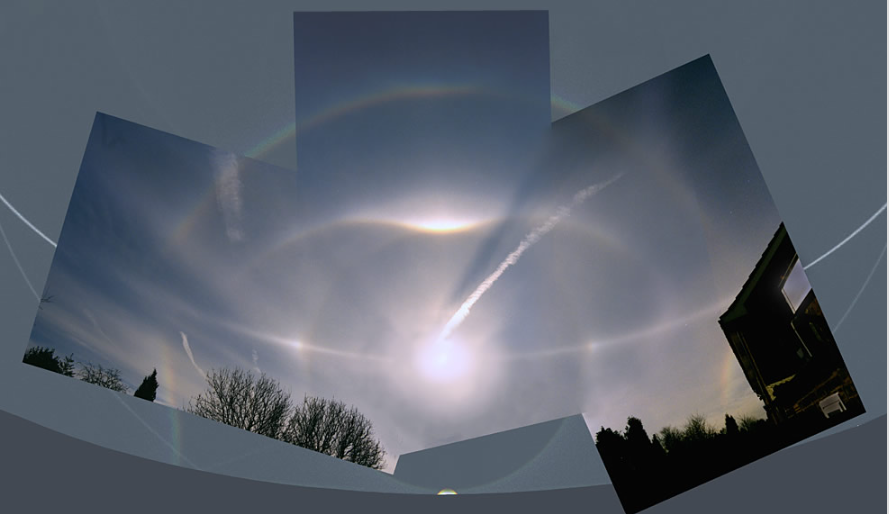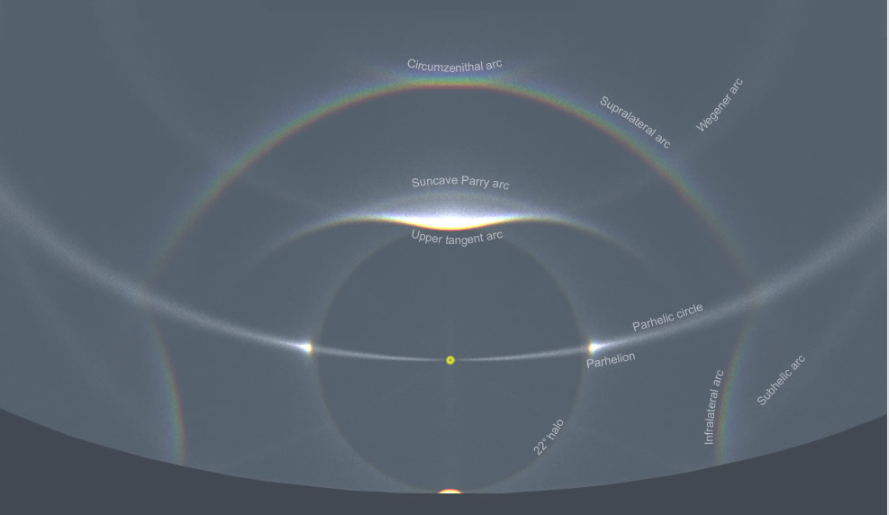England Halo Display February 9, 2001
England Halo Display February 9, 2001: A Spectacular Atmospheric Phenomenon
On February 9, 2001, residents of Yorkshire, Lancashire, and the Midlands in England were treated to a mesmerizing display of atmospheric optics. The skies were adorned with vibrant halos, captivating onlookers with their ethereal beauty. One observer, Ray Martin, captured the enchanting scene from Sutton Coldfield, a few miles north of Birmingham.
Comparing this display to a South Pole phenomenon with the same solar altitude revealed striking similarities. It became evident that the UK is capable of showcasing spectacular halos, dispelling any notion that such phenomena are exclusive to polar regions.
The dominant halos observed during this event were formed by horizontal column crystals. These crystals gave rise to several noteworthy features, including exceptionally bright supralateral and infralateral arcs. An almost blinding upper tangent arc and a faint hint of a diffuse Wegener arc further added to the allure of the display. Interestingly, the aircraft trail seen above the halo-forming ice crystal layer cast a shadow downward onto it, enhancing the visual impact of the scene.
To better understand the intricacies of this atmospheric spectacle, Ray Martin's images were subjected to HaloSim simulations. These simulations provided valuable insights into the specific types of crystals responsible for each halo formation. The results indicated that the majority of crystals present were columns with a 1° tilt dispersion and a c/a ratio (crystal aspect ratio) of 1.2. Random columns with a c/a ratio of 2 accounted for 10% of the crystal population. Additionally, plates with a 2° tilt dispersion and a c/a ratio of 0.1 made up 5% of the crystals, while plates with a 6° tilt dispersion and the same c/a ratio represented 6% of the population. Surprisingly, only a small percentage (3%) of Parry crystals with a 1° tilt and a c/a ratio of 2 were needed to generate the observed arc. Although Parry orientations may seem improbable, the efficiency of Parry rays in halo formation is remarkable.
The HaloSim simulations utilized 256 color levels and an impressive 30 million rays, providing a comprehensive analysis of the halo display. This meticulous approach allowed for a detailed examination of the various elements at play, shedding light on the underlying physics and optics behind the captivating phenomenon.
The England Halo Display of February 9, 2001, serves as a reminder of the wonders that can unfold in our skies. It showcases the intricate interplay between sunlight and ice crystals, resulting in a breathtaking visual spectacle. Such displays not only captivate the imagination but also provide valuable insights into the behavior of light in our atmosphere.
While this particular event was a momentary occurrence, it reminds us of the ever-changing nature of our atmosphere and the potential for extraordinary optical phenomena. By studying and documenting these phenomena, we deepen our understanding of atmospheric optics and unlock the secrets of our mesmerizing skies.
The images captured by Ray Martin during this event offer a glimpse into the beauty that can be found above us, encouraging us to look up and appreciate the wonders that lie beyond our everyday experiences.

England February 9, 2001 - Yorkshire, Lancashire and the Midlands saw bright displays. Ray Martin took this montage from Sutton Coldfield a few miles north of Birmingham. Comparison with a South Pole display of the identical solar altitude shows the same major halos and that spectacular halos can be seen in the UK. Horizontal column crystals formed most of the halos with very bright supralateral and infralateral arcs, an almost blinding upper tangent arc and a hint of a diffuse Wegener arc. The aircraft trail was above the halo-forming ice crystal layer and casts a shadow downwards onto it. A matching HaloSim simulation below identifies the halos. Images ©Ray Martin, shown with permission.

HaloSim ray tracing for a solar elevation of 22.5°. Crystals: 76% columns 1° tilt dispersion c/a=1.2, 10% random columns c/a=2, 5% plates 2° tilt disp c/a=0.1, 6% plates 6° tilt disp c/a=0.1, 3% Parry 1° tilt c/a=2. Very few Parry crystals are needed to make the arc, Parry orientations seem appear very improbable but, conversely, Parry rays are very efficient at halo formation. 256 colour levels, 30 million rays.
Note: this article has been automatically converted from the old site and may not appear as intended. You can find the original article here.
Reference Atmospheric Optics
If you use any of the definitions, information, or data presented on Atmospheric Optics, please copy the link or reference below to properly credit us as the reference source. Thank you!
-
<a href="https://atoptics.co.uk/blog/england-halo-display-february-9-2001/">England Halo Display February 9, 2001</a>
-
"England Halo Display February 9, 2001". Atmospheric Optics. Accessed on April 16, 2024. https://atoptics.co.uk/blog/england-halo-display-february-9-2001/.
-
"England Halo Display February 9, 2001". Atmospheric Optics, https://atoptics.co.uk/blog/england-halo-display-february-9-2001/. Accessed 16 April, 2024
-
England Halo Display February 9, 2001. Atmospheric Optics. Retrieved from https://atoptics.co.uk/blog/england-halo-display-february-9-2001/.